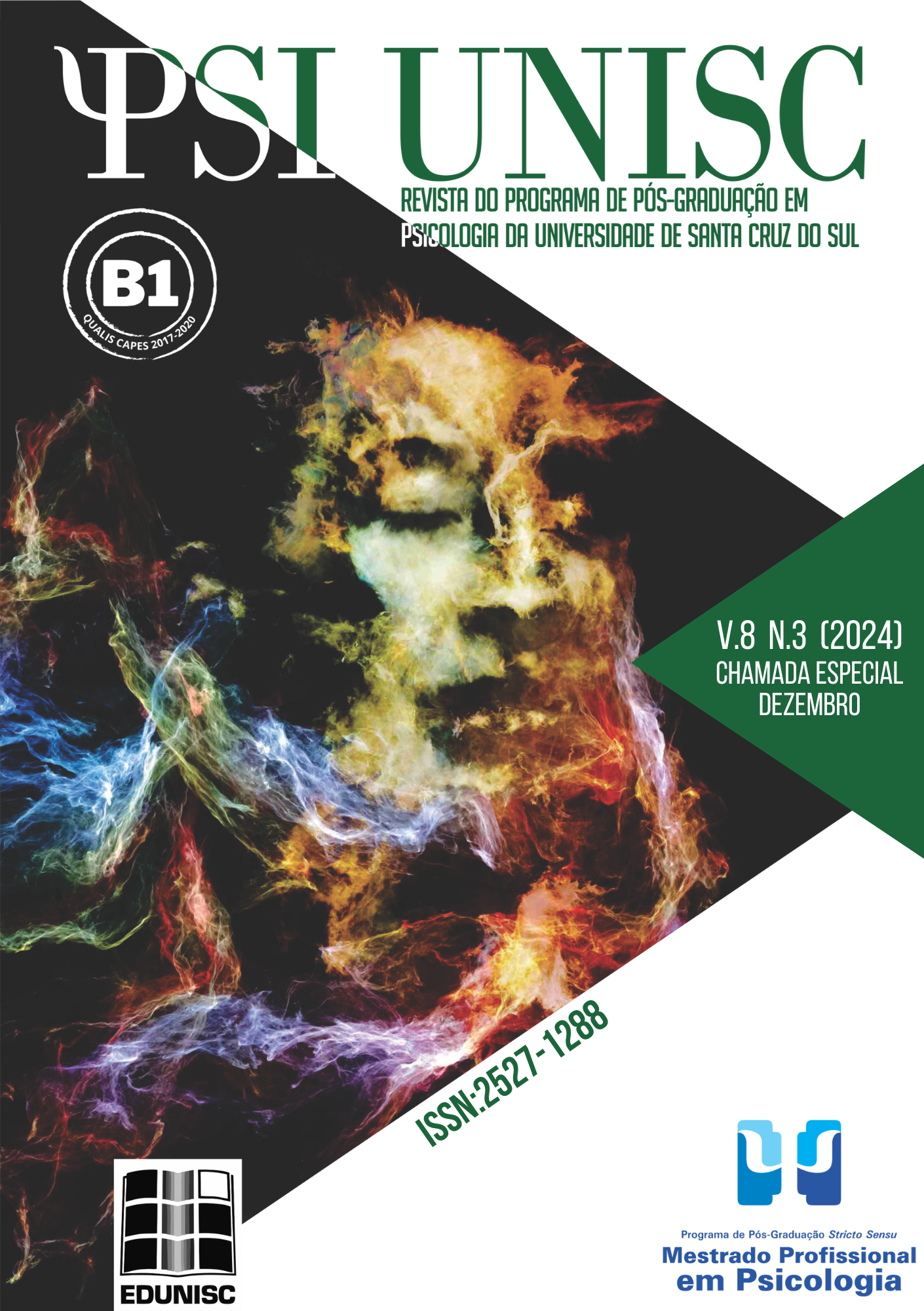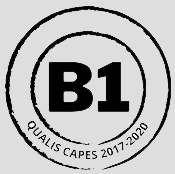Compassion fatigue and disaster situations: a narrative review
DOI:
https://doi.org/10.17058/psiunisc.v8i3.19634Keywords:
compassion fatigue, disasters, workers health, impact of the disaster, quality of professional lifeAbstract
Compassion Fatigue (CF) involver cognitive and symbolic changes resulting from exposure to the pain and suffering of others. Therefore, the study aimed to identify how the scientific literature presents Compassion Fatigue in professionals who work in disaster situations. This is a Narrative Literature Review, with a systematic search in three databases, based on the descriptors “Compassion Fatigue” AND “Disasters”, in Portuguese, English and Spanish. The investigation took place from October to December 2023. A total of 28 articles were part of this review. The findings were grouped into four categories: Presence of CF, Burnout Syndrome and Secondary Traumatic Stress; Causes, effects and risk factors associated with the occurrence of CF in disaster situations; Disaster impacts and aid professionals and Disaster coping and mitigation strategies and CF interventions. The literature indicates that professionals who work in disasters are exposed to CF, in addition to implications for the health of these workers which suggests that coping and care strategies such as individual prevention and investments in psychological resources. Continuous specialized listening is necessary, which considers the demands of professionals and the scenario in which the disaster occurs.
Downloads
References
Abregú-Tueros, L. F. (2020) Revisión sistemática de las prácticas preventivas para
riesgos psicosociales en centros sanitarios ibero-americanos. Medwave, 20(7), 1-24.http://doi.org/10.5867/medwave.2020.07.8000
Adams, R. E., Figley, C. R., Boscarino, J. A. (2008). The Compassion Fatigue Scale: Its
Use With Social Workers Following Urban Disaster. Research on Social Work
Practice, 18(3), 238-250. https://doi.org/10.1177/1049731507310190
Araujo, I. C., Menezes, I. V. (2018). Fadiga por compaixão: os custos do cuidado.
Curitiba: CRV.
Atkins, C., Burnett Júnior, H. J. (2016). Specialized disaster behavioral health training:
Its connection, with response, practice, trauma health, and resilience. Disaster
Health, 3(2), 57-65. https://doi.org/10.1080/21665044.2016.1199151
Back, A., Deignan, P. F., Potter, P. A. (2014). Compassion, compassion fatigue, and
burnout: key insights for oncology professionals. American Society of Clinical
Oncology Educational Book, 34(34), 454-459.
https://doi.org/10.14694/EdBook_AM.2014.34.e454
Baker, J., Vicent, R. (2024) Compassion fatigue in community nursing: what is it, who
is susceptible, and what can be done? British Journal of Community Nursing,
(3)132-136. https://doi.org/10.12968/bjcn.2024.29.3.132
Bales, M. et al. (2022). Quantifying Compassion Fatigue in Ancillary and Clinical Staff
in an Adult Emergency Department. The Western Journal of Emergency Medicine, CA, 23(6) 841-845. https://doi.org/10.5811/westjem.2022.8.57733
Barboza, L. C. A. et al. (2022). Atuação do enfermeiro em situações de desastres
naturais: uma revisão integrativa. Research, Society and Development, 11(1),
e44811124836. https://doi.org/ 10.33448/rsd-v11i1.24836
Bardin, L. (2016). Análise de conteúdo. São Paulo: Edições 70.
Batista, F. E. S. et al. (2021). Desastres biológicos e sua relação com a saúde coletiva:
uma análise dos artigos publicados no estado do Paraná, Brasil. Ciência & Coletiva, 26(4) 1391-1399. https://doi.org/10.1590/1413-81232021264.14402019
Boscarino, J. A. (2015). Community Disasters, Psychological Trauma, and Crisis
Intervention. International Journal of Emergency Mental Health, 17(1) 369- 371.https://pubmed.ncbi.nlm.nih.gov/25983663/
Boscarino, J. A., Figley, C. R., Adams, R. E. (2004). Compassion fatigue following the
September 11 terrorist attacks: a study of secondary trauma among New York City social workers. International Journal of Emergency Mental Health, 6(2),57-66. https://www.ncbi.nlm.nih.gov/pmc/articles/PMC2713725/
Cielusinsky, A. D. (2021). Análise da Força Tarefa do Corpo de Bombeiros Militar de
Santa Catarina e sua Respectiva Atuação de Resposta na Operação Brumadinho MG. Ignis: Revista Técnico Científica do Corpo de Bombeiros Militar de Santa Catarina, 6(1), 1-15. https://ignis.emnuvens.com.br/revistaignis/article/view/132/102
Clukey, L. (2010). Transformative experiences for Hurricanes Katrina and Rita disaster-
volunteers. Disasters, 34(3), 644-656. https://doi.org/10.1111/j.1467 7717.2010.01162.x
Dalagasperina, P.et al. (2021). Estrutura Interna da Versão Brasileira do Questionário de
Estresse Traumático Secundário. Psico-USF, 26(2), 319- 332.
https://doi.org/10.1590/1413-82712021260210
Dang, W. et al. (2015). Reliability and validity of Professional Quality of Life Scale
among government staff in earthquake - stricken areas in China. Zhonghua Lao
Dong Wei Sheng Zhi Ye Bing Za Zhi, 33(6), 440-443.
https://pubmed.ncbi.nlm.nih.gov/26653379/
Deng, M., Li, Z., Tao, F. (2022). Rainstorn Disaster Risk Assessment and Influence
Factors Analysis in the Yangtze River Delta, China. International Journal of
Environmental Research and Public Health, 19(15), e9497.
https://doi.org/10.3390/ijerph19159497
Figley, C. R. (ed.). (1995). Compassion fatigue: coping with secondary traumatic stress
disorder in those who treat the traumatized. Nova Iorque: Brunner-Routledge.
Frank, D. I., Adkinson, L. F. (2007). A developmental perspective on risk for
compassion fatigue in middle-aged nurses caring for hurricane victims in Florida.
Holistic Nursing Practice, 21(2) 55-62. https://doi.org/10.1097/01.HNP.0000262018.49550.5a
Gurowiec, P. J. et al. (2022). The Relationship between Social Support and Secondary
Posttraumatic Growth among Health Care Providers Working with Trauma Victims-The Mediating Role of Cognitive Processing. International Journal of Environmental Research and Public Health, 19(9), e4985. https://doi.org/10.3390/ijerph19094985
Hawsawi, S. (2022). Alleviating psychological symptoms in nurses during disease
outbreaks: Na integrative review. International Nursing Review, 69(4), 470-483. https://doi.org/10.1111/inr.12756
Ishiwatari, M., Sasaki, D. (2023). “Disaster Risk Reduction and Climate Change
Adaptation: Na Interdisciplinary Approach”. International Journal of Environmental Research and Public Health, 20(3), e2641. https://doi.org/10.3390/ijerph20032641
Jang, S. J., Kim, H., Lee, H. (2022). Mental health nurses disaster nursing
competencies: A cross-sectional study. International Journal of Mental Health
Nursing, 31(1), 142-152. https://onlinelibrary.wiley.com/doi/epdf/10.1111/inm.12944
Jilou, V. et al. (2021). Fatigue due to compassion in health professionals and coping
strategies: a scoping review. Revista Brasileira de Enfermagem, 74(5), 1-11.
https://doi.org/10.1590/0034-7167-2019-0628
Kitano, M. et al. (2021). Validity and reliability of the Secondary Traumatic Stress
Scale-Japanese version. Neuropsychopharmacology Reports, 41(4), 476-484.
https://doi.org/10.1002/npr2.12207
Lopes, H. L., Barbosa, S. C da. (2020). Qualidade de Vida Profissional: o que mantém o
bem-estar psíquico de bombeiros? Revista Psicologia: Organizações e Trabalho
(rPOT), 20(2), 1002-1010. https://doi.org/10.17652/rpot/2020.2.18277
Lu, M. H. et al. (2020). Predictors of professional quality of life among nursing staff
following the Taiwan Formosa Fun Coast Explosion. Burns: journal of the
International Society for Burn Injuries, 46(2), 423-429.
https://doi.org/10.1016/j.burns.2019.02.010
Maslach, C., Leiter, M. (2016). New insights into burnout and health care: Strategies for
improving civility and alleviating burnout. Medical Teacher, 39(2), 160-163.
https://doi.org/10.1080/0142159X.2016.1248918
Mclennan, J. et al. (2016). Secondary Traumatic Stress in Postdisaster Field Research
Interviewers. Journal of Traumatic Stress, 29(1) 101-105.
https://doi.org/10.1002/jts.22072
Miranda, D. M. et al. (2021). Impactos físicos e psicológicos na população de
Brumadinho após rompimento da barragem de rejeitos. Revista Médica de Minas Gerais, 31(e31212). https://dx.doi.org/10.5935/2238-3182.2021e31212
Morgan, P. M. (2016). The psychological impact of mass casualty incidents in first
responder: A systematic review. Journal of Emergency Management, 14(3), 213-226. https://doi.org/10.5055/jem.2016.0287
Nagamine, M. et al. (2018). The relationship between dispositional empathy, psychological
distress, and posttraumatic stress responses among Japanese uniformed disaster workers: a cross-sectional study. BMC Psychiatry, 8(1), 1-7. https://doi.org/10.1186/s12888-018-1915-4
Patel, S. et al. (2023). Surveying mental health stressors of emergency management
professionals: factors in recruiting and retaining emergency managers in an era of disasters and pandemics. Journal of Emergency Management, 21(5), 375-384.
https://doi.org/10.5055/jem.0820
Pietrantoni, L., Prati, G. (2008). Resilience among first responders. African Health
Sciences, 8(1), 1-12. https://pubmed.ncbi.nlm.nih.gov/21448365/
Powell, T., Yuma-Guerrero, P. (2016). Supporting Community Health Workers After
a Disaster: Findings From a Mixed-Methods Pilot Evaluation Study of a
Psychoeducational Intervention. Disaster Medicine and Public Health Preparedness, 10(5), 754-761. https://doi.org/10.1017/dmp.2016.40.
Prati, G., Pietrantoni, L., Cicognani, E. (2010). Self-efficacy moderates the relationship
between stress appraisal and quality of life among rescue workers. Anxiety Stress and Coping, 23(4), 463-470. https://doi.org/10.1080/10615800903431699.
Prati, G., Pietrantoni, L. (2009). Critical incidents and quality of life among rescue
workers. Giornale Italiano di Medicina del Lavoro ed Ergonomia, 31(3), 5-11.
http://worldcat.org/issn/15927830
Ratzon, A. et al. (2022). Resilience at Work, Burnout, Secondary Trauma, and Compassion
Satisfaction of Social Workers Amidst the COVID-19 Pandemic. International Journal of Environmental Research and Public Health, 19(9), 1-14. https://doi.org/10.3390/ijerph19095500
Romano, B. et al. (2023). Caminhos da participação popular na saúde mental: uma revisão
narrativa. Saúde e Sociedade, 32(2), 1-12.
https://doi.org/10.1590/S0104-12902023210875pt
Roney, L. N., Acri, M. C. (2018). The cost of caring: an exploration of compassion
fatigue, compassion satisfaction, and job satisfaction in pediatric nurses. Journal of
Pediatric Nursing, 40, 74–80. https://doi.org/10.1016/j.pedn.2018.01.016.
Rushforth, A. et al. (2023). Self-Compassion Interventions to Target Secondarfy
Traumatic Stress in Healthcare Workers: A Systematic Review. International
Journal of Environmental Research and Public Health, 20(12), e6109.
https://doi.org/10.3390/ijerph20126109.
Saura, A. P. N. S. et al. (2023). Fadiga e satisfação por compaixão em profissionais
oncológicos: revisão integrativa. Revista Bioética, 31(e3073), 1-14.
https://doi.org/10.1590/1983-803420233073PT
Setou, N. et al. (2018). Factors related to the fatigue of relief workers in areas affected by
the Great East Japan Earthquake: survey results 2.5 years after the disaster. BioPsychoSocial Medicine, 12(14), 1-8. https://doi.org/ 10.1186/s13030-018-0133-0.
Silva, W. M. da. (2019). Contribuições e Limitações de Revisões Narrativas e Revisões
Sistemáticas na Área de Negócios. Revista de Administração Contemporânea, 23(2), 1-11. https://doi.org/10.1590/1982-7849rac2019190094
Smith, E. et al. (2021). Vicarious Trauma: Exploring the Experiences of Qualitative
Researchers Study Traumatized Populations. Disaster Medicine and Public Health Preparedness, 17(e69). https://doi.org/10.1017/dmp.2021.333
Sousa, L. M. M. de. et al. (2018). Revisões da literatura científica: tipos, métodos e
aplicações em enfermagem. Revista Portuguesa de Enfermagem de Reabilitação, 1(1), 45–54. https://doi.org/10.33194/rper.2018.v1.n1.07.4391
Souza, A. P., Freitas Júnior, J. S. de. (2021). A Inteligência Operacional Aplicada ais
Resgates em Desastres: a atuação dos bombeiros no rompimento da barragem de
mineração em Brumadinho/MG – Brasil. Territorium: Revista Internacional de
Riscos, 28(1), 35-51. https://doi.org/10.14195/1647-7723_28-1_3
Stamm, B. H. (2010). The concise ProQOL manual. Pocatello, ID: ProQOL.org.
Stout, R. A., Kostamo, S., West, S. (2021). Burnout, compassion fatigue, and vicarious
trauma among wildfire responders. Journal of Emergency Management, 19(5), 451-460. https://doi.org/10.5055/jem.0653
Sullivan, S., Germain, M.L. (2020). Psychosocial risks of healthcare professionals and
occupational suicide. Industrial and Commercial Training, 52(1), 1-14.
https://doi.org/10.1108/ICT-08-2019-0081
Trotzky, D. et al. (2023). Resilience of hospital staff facing COVID-19 pandemic: Lessons
from Israel. Frontiers in Public Health, 11(1050261), 1-8.
https://doi.org/10.3389/fpubh.2023.1050261
Tugba, Y. (2021). Victimology from clinical psychology perspective: psychological
assessment of victims and professionals working with victims. Current Psychology,
(4), 1592-1600. https://doi.org/10.1007/s12144-021-01433-z
United Nations Office For Disaster Risk Reduction - UNDRR. (2024). Recommendations
of the United Nations Senior Leadership Group on Disaster Risk Reduction for Resilience. [Versão em inglês].
Van Der Auwera, M., Debacker, M., Hubloue, I. (2012). Monitoring the mental well-
being of caregivers during the Haiti-earthquake. Plos Currents, 4(e4fc33066f1947), 1-14. https://doi.org/10.1371/4fc33066f1947
World Health Organization – WHO. (2019). Burn-out na “occupational phenomenon”:
International Classification of Diseases. Geneva: WHO.
Xu, Z. et al. (2024). Prevalence and associated factors of secondary traumatic stress in
emergency nurses: a systematic review and meta-analysis. European Journal of
Psychotraumatology, 15(1), 1-16, 2024.
https://doi.org/10.1080/20008066.2024.2321761
Yeung, P. et al. (2021). What Helps Oiled Wildlife Responders Care for Animals While
Minimizing Stress and Compassion Fatigue. Animals, 11(7), 1-20. https://doi.org/10.3390/ani11071952
Downloads
Published
How to Cite
Issue
Section
License
The submission of originals to this journal implies the transfer, by the authors, of the printed and digital publication rights. The copyrights for the published articles are those of the author, with periodical rights on the first publication. Authors may only use the same results in other publications clearly indicating this journal as the medium of the original publication. Because we are an open access journal, we allow free use of articles in educational and scientific applications provided the source is cited under the Creative Commons CC-BY license.




